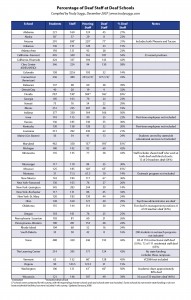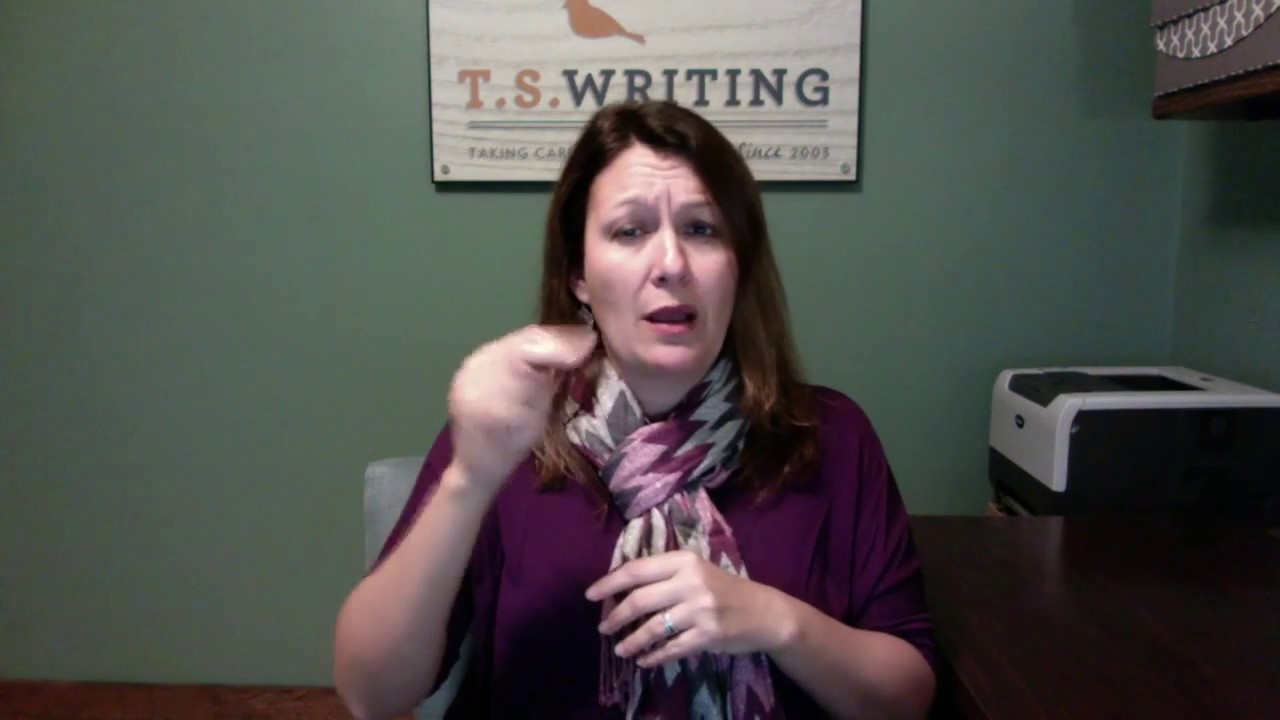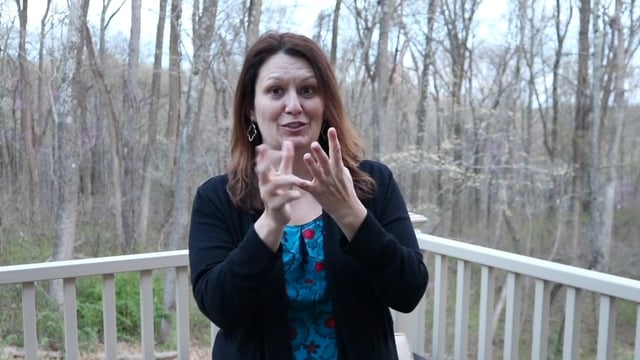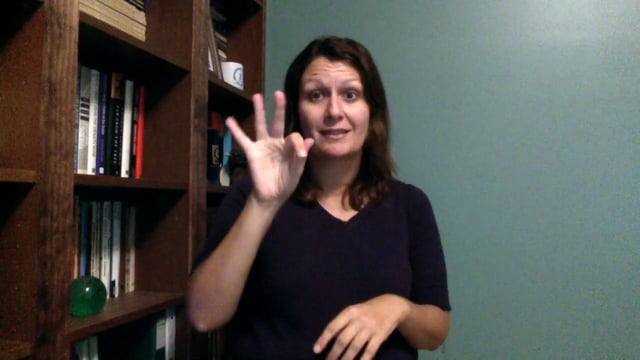This article originally appeared at i711.com.
In 1997, an article published in DeafNation Newspaper examined staff numbers at 21 residential schools in the U.S. Only three schools reported having more than 40 percent of staff—including all levels of employees, such as maintenance, administrators, dorm staff and teachers—who were deaf or hard of hearing, Ten years later, at least five schools report having broken the 50 percent mark; see chart at right.
The residential school has long played a pivotal role in the Deaf community, given its strong, deep roots in Deaf education history. With the 1817 establishment of American School for the Deaf, in Hartford, Conn., residential schools have since served as a social, educational and language source for many. In fact, it is often at such schools that deaf people are given language and meet deaf role models for the first time in their lives.
Effects of Deaf Staff
In the 1997 article, Brian Sipek, then a junior at the Illinois School for the Deaf, said, “The [hearing] staff are usually not familiar with what the student needs, being a deaf person. There are some hearing teachers, I admit, that try to be very helpful to deaf students, but it’s not the same coming from them, since they were never raised as a deaf person. They’re just not as familiar with being deaf as we are.”
Are students and communities better served through a large number of deaf employees at deaf schools? “Without question, a diverse faculty and staff impact positively on students’ motivation to achieve academically and to set their sights high,” says Texas School for the Deaf (TSD) superintendent Claire Bugen, who is hearing. “Deaf role models are part of the fabric of our educational environment.”
The positive effects of having deaf staff at residential schools are unquestionable, but most schools continue to have more hearing employees than deaf. Sipek feels this should be changed. “I still believe that there is a shortage of deaf and hard of hearing role models for these young students at the residential schools. Being a minority, deaf and hard of hearing children need role models, someone who views the world in the same way that they do, to look up to and be inspired by. “
Indiana School for the Deaf (ISD) superintendent David Geeslin, Ph.D., who is deaf, believes having deaf people on staff is a reason for ISD’s enrollment rising dramatically to 377 students within a few years. “Obviously, with deaf staff, we have a greater number of deaf role models for students, and this also leads to increased exposure to bilingualism for the students,” he says. “Deaf people can share knowledge that no college education can provide.”
Language is another benefit to having deaf staff, says Alex Slappey, Wisconsin School for the Deaf (WSD) superintendent. “Language is learned through the interchange of the language, and the richer and more diverse the language models available, the richer and more diverse the language foundation will be. It’s essential that students at WSD, an American Sign Language/English bilingual program, have the language models that both peers and adults provide. It is equally important that we have hearing staff because we are a bilingual program and provide the cultural and language models our students require to develop English language skills and an understanding of the hearing culture.”
Geeslin adds, “Even so, it’s critical that we maintain a bicultural environment where hearing staff are also equally respected and revered, especially if they’re fluent in both American Sign Language (ASL) and English and have the right attitude.”
Obstacles
Among the several reasons cited in the 1997 articles for having such low percentages of deaf staff were widening career choices for deaf professionals, hiring systems, pay levels, and certification procedures. These appear to continue to be challenges today.
“There are so many more professional employment opportunities today for people who are deaf and many more pre-service training and educational opportunities than there used to be. All of this is great, but it means that many capable individuals are seeking and finding challenging employment outside of the education arena,” says Joseph Finnegan, director of Conference of Educational Administrators of Schools and Programs for the Deaf (CEASD). “Also, I think that many individuals don’t see educational administrative employment as very attractive these days, especially with long hours, low pay and many headaches.” CESAD, established in 1868, provides accreditation for deaf schools, and advocacy and program services.
“The state hiring process may inadvertently discriminate against qualified deaf and hard of hearing candidates. This is less true for direct contact staff in Wisconsin, such as teachers, assistants, and dorm staff. We were successful in changing requirements for that in the early 1990s. However, it continues to be true for non-contact staff such as building/grounds and food services staff,” Slappey theorizes. “Bureaucratic certification systems are also impediments to hearing, deaf, or hard of hearing candidates, and can be rather discouraging.”
“I think there are both positives and negatives that contribute to this dilemma of a lack of deaf staff. Clearly, deaf people have many more career choices today than in the past, and with changing technology I suspect that will only continue to be a factor – that’s a good thing,” Bugen adds. “Salaries in education, on the other hand, have not kept pace with the private sector and many young people both want and need to be paid better than most educators are paid. Now with the requirements of highly qualified teaching under various laws, our already shrinking pool of qualified deaf and hearing candidates is compromised even further, which will likely cause more challenges in the years ahead.”
Geeslin is less forgiving. “Even though circumstances for gaining certification have become much stringent, the harsh truth is that we have to roll up our sleeves, whether we’re deaf or hearing or whatever our languages are, and work as much as we can to meet requirements. There’s no way around it at this point. We have to actually try and do what we can to earn our credentials, because we can. After all, we are to serve as models for students. It is time to raise the bar for ourselves and our students.”
Deaf Administrators
Currently, there are at least 14 deaf or hard of hearing superintendents in the nation, a number that fluctuates with time. “I foresee a need for more deaf administrators at deaf schools, but I think the pool of qualified candidates is smaller than it could be,” Slappey says. “Finding good administrators, whether hearing or deaf, is a problem. States are now more aware of and sensitive to the value a good deaf administrator brings to a program.”
Finnegan, a former superintendent, notes that graduate-level or professional-level training for deaf people were nonexistent for years, especially after the closure of the Leadership Training Program at California State University, Northridge, but that this is changing with the establishment of the Gallaudet Leadership Institute (GLI).
Training may be key, Bugen agrees, who also cites GLI. “Given the growing scarcity of young deaf or hearing professionals interested in education, we have to groom and grow our future leaders from within. We have to find ways to give our talented young deaf people opportunities to take on leadership roles and then encourage them to get the proper certification and training to assume administrative positions.”
“I think another challenge is that so many deaf administrators try to buck the system head-on instead of working within the system,” Dr. Geeslin states. “What helps me in my current position greatly are my years in outreach. I was out in the field, and I saw how hearing parents often didn’t care about Deaf culture. They simply wanted to find the best options for their children in acquiring spoken and/or written English. I had to come up with different ways of sharing the idea of using ASL to acquire English, and that really helped me understand the reality of working within the system in order to buck it. It’s all about mediating between the two worlds.”
New Challenges
What makes the enrollment boom that some residential schools are experiencing even more remarkable is that a Dec. 4 article in Education Week reported that only 15 percent of 72,000 K-12 deaf students attend deaf schools, down from 33 percent in 1985.
“I think there are two important elements that contribute to this success. The first is a community with a critical mass of Deaf people and a school that offers a high quality educational program. We find an increasingly large number of Deaf families moving to the Austin area so that their children can attend TSD,” Bugen says. “When this happens it not only keeps our enrollment strong, but it brings more Deaf families into the larger business and social community of Austin. Second, I believe the school must be ‘Deaf friendly’ and involve Deaf people in all aspects of the school’s operations so that Deaf people feel respected, valued and empowered.”
Serving a specific niche is another significant boost, Slappey says. “The landscape of deaf education has been changing and continues to change. Deaf schools, especially residential schools, need to decide where their focus is going to be in terms of who they will serve and how they will serve their students. WSD considers itself a niche school that serves children who require a visual language, ASL, to access education. This doesn’t mean we don’t serve the more hard of hearing child who uses English, but we do not sacrifice the needs of the ASL child to meet the needs of the English child. Deaf schools need to show how their uniqueness may make them a better placement option. To a large degree, this is an education and public relations issue. We must educate as to the unique needs, especially the communication and social emotional needs, of our deaf children.”
Even so, schools are struggling with an emergent problem: students with additional disabilities, such as autism or attention deficit disorder. According to Education Weekly, a 2005 survey indicated that 42 percent of 37,000 deaf students reported having additional disabilities. Dr. Geeslin, noting that 52 percent of ISD’s students have other disabilities, says that the lack of deaf teachers specializing in special education is a dilemma. “Now with the proliferation of students with additional needs, it’s even more crucial that deaf teachers pursue certification and experience in working with those students. The students are the ones who need the best language and cultural role models. And who knows? With earlier intervention and clear language models, it may be that those students make greater progress in acquiring both languages improving academic performance.”
Citing changes in federal and state statutes, Slappey says, “It is not a trend limited to teachers of the deaf, but part of the overall trend. To realize a true change in the supply, the teaching profession needs to be made more attractive as a career choice. Such things as better compensation, better working conditions, less bureaucracy, and less paperwork would go a long way to that extent. It’s a huge order to attempt to implement.”
‘Grow Our Own’
Despite the hurdles, Geeslin believes he has the solution to ensuring stronger roots and equality at deaf schools.
“15 years ago, I went to the National Association for the Deaf conference and ran into a friend, Lindsay Dunn. Given that I’ve always tried to look at things from outside of the box even as a teacher, I had been thinking about the lack of diversity at ISD. So I asked Lindsay how we could bring more African-Americans to the school. He said, ‘I have the answer. First, what did you do to recruit them?’ I told him that we had asked many people, but none ever applied. He then asked if we had a strong black deaf community, and I said we did not. He asked if we had any black deaf teachers. I again said we did not. He said, ‘There you have it. You have to grow your own first.'”
Profoundly affected by this revelation, Geeslin’s outlook changed. “Thanks to Lindsay, I have tried to ensure that we grow our own by encouraging staff, students and parents to invest in the community, and making sure that they understand they are investments themselves, too. We have to do this to create a community to which people of all types want to return and continue the work previous generations did. This is one reason ISD has grown so much in such a short time – because we grow our own.”
The fact that more schools have broken the 50 percent mark comes as good news to Sipek, who graduated Gallaudet University in 2004 and now works at the university. “I’m thrilled to know that there are more role models for deaf and hard of hearing children at residential schools. This closes a much-needed gap, but like most things, there is always room for more. I think this increase in staff numbers has been a long time coming.”
My thoughts:
This article first came about in 1997 when Brian Sipek asked me to see how many schools had deaf people employed at deaf schools. I agreed, and set out to collect the data. I was surprised at the amount of resistance from schools in giving me the statistics I asked for—something that was also true this time around. But I was even more surprised at the staggeringly low numbers, and how defensive some schools were about the numbers. My questions were simple: 1. How many students attend your school? 2. How many people do you employ? 3. How many of those staff members are deaf or hard of hearing?
Those who did not try to justify their low percentages were the ones who had outstanding attitudes, were upfront about this being a concern, and worked hard to change the numbers.
I am beyond thrilled to see how the numbers have grown since 1997, even if only a few have broken the 50 percent barrier. I should also point out that the numbers of deaf and hard of hearing teachers and dorm staff at many schools are quite high, and that the low numbers usually stemmed from cafeteria workers, maintenance, and administration. This is in no way an excuse; we should have deaf employees in each of these categories, too.
As Sipek commented, we still have a long way to go. Regardless of changing needs and times, we must continue to promote the increased hiring of qualified deaf people in key positions at every level. After all, paraphrasing Lindsay Dunn, it’s the only way we can grow our own.
Copyrighted material. This article can not be copied, reproduced, or redistributed without the express written consent of the author.





